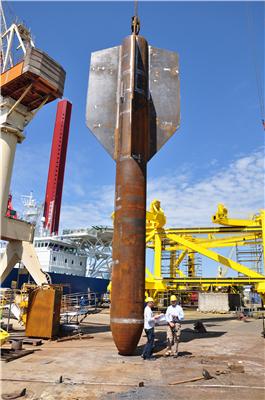Dec 16 2009
Maybe it looks like a giant arrow or a rocket, but this 13 metre-long, 80-tonne anchor is currently being tested as a new mooring concept for offshore installations.
 Two of the new anchors are tested these days in the North Sea
Two of the new anchors are tested these days in the North Sea
Entrepreneur Jon Tore Lieng is the man behind the new "Deep Penetrating Anchor". His story shows how an idea conceived atSintef, combined with drive and persistence, can bring good, cost-effective technology to the market.
In the 90s, when petroleum production began moving towards deeper waters, Lieng was a geotechnologist with SINTEF. He envisaged a better solution than the box-like suction anchors of the time that were placed on the seabed. These are open at the bottom and function by pumping out the water inside, thus creating a vacuum that pulls the anchor into the substrate so that it holds solid. However, the need to carefully orient such anchors, and their sensitivity to high seas and waves, makes for problems when they are being deployed, in many cases involving delays that can cost millions a day.
乔恩(Jon)tore lieng认为,最简单的概念是将足够重的锚点直接放入海中。如果它足够重,并且移动得足够快,那么这样的锚将迫使其进入海床并创造和更强大的握持。
自由下落
两个新锚已经安装在巨魔场附近的Statoilhydro的Gjøa场上。这些锚是在立陶宛制造的,并已获得Veritas的批准,分别穿透了31和42米的海床。
The new anchors are not affected by waves, and the installation process is the same whether they are being deployed at depths of 500 or 3000 metres. Each anchor starts its descent under cable control, but for the final 75 m it drops in free fall until it reaches a speed of 100 kph.
A remotely operated vehicle (ROV) follows the manoeuvre and transmits the acoustic signal that releases the anchor for the final stage of the descent. Then ROV then goes down to check the situation on the seabed, and the chain is tightened up.
平台的典型系泊配置将由位于三到四组的12-16个锚组成。所有锚可以由单个辅助船携带,并在一次野外旅行过程中部署。
研究和测试
The path to today's full-scale trials has been long. At the same time as the offshore industry was beginning to move to deeper waters in the 80s, the Research Council of Norway launched its deepwater and offshore programmes, which were looking for proposals for new mooring technologies.
At that time, Lieng carried out a theoretical study, which he sent to all the oil companies that were based in Norway. His unusual concept was turned down, but at least the companies became aware that he was working in this area.
1997年,Lieng离开Sintef并建立了自己的公司Geoprobing Technology,并获得了专利许可。过了一会儿,他与喜欢他想法的Statoil中的人们进行了联系,并在1998年和1999年进行了资助可行性研究和模型测试。这个想法是找出锚需要多大的大小,以及它的成本。
科学家很快就确定了新的锚定概念的成本将比当时使用的技术低约35%。由于我们在这里谈论了数亿个Kroner,因此这意味着一个巨大的节省。
In spring 2003, Lieng and the Statoil scientists moved into the Trondheimsfjord to test a 4-metre scaled-down version of the anchor. But the fibre cable attached to the anchor broke near the seabed when they were testing its holding power, and the anchor was lost.
"As well as the anchor itself, all the instrumentation was installed in its tail-end," says Lieng. "That was a bad day."
The anchor lay on the seabed for three years before it was found again and another company took on the job of bringing it to the surface. Meanwhile, the project was abandoned, and Jon Lieng worked as a consultant in offshore marine geotechnology.
全面试验
然而,在那个低点之后,事情再次开始移动。Statoilhydro目前正在评估挪威沿岸的许多开发项目,其中涉及约1000米的深度,以及墨西哥湾的30个左右的深水田地,它们的深水范围超过2000米。这些将具有成本效益的系泊的问题重新引起了人们的关注。
The Gjøa field is the first full-scale trial being run by StatoilHydro, and the concept is gradually gaining acceptance.
Jon Lieng himself is in the national and international marketing phase, visiting field development operators, oil companies and offshore companies that supply mooring systems.
"I am counting on making us known as one of several possibilities, and I believe that we can make our mark in the competition to supply mooring system, in terms of both price and robustness," says this quiet-spoken entrepreneur.